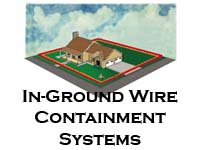IN-GROUND DOG FENCES
Electric Dog Fences
Underground Dog Fence | Pet Fence | Invisible Fence
 In places where an actual physical barrier is not allowed or
practical, an electronic dog containment system might be a nice
alternative. Dog containment systems
consist of two primary components, the transmitter and the receiver. The transmitter is often a stationary base
unit with a transmission cable or wire (used to establish a perimeter or
electronic barrier), while the receiver is worn by the dog(s). When the pet approaches the transmitter
cable, the pet will receive a stimulus causing it to withdraw from the
transmitter.
In places where an actual physical barrier is not allowed or
practical, an electronic dog containment system might be a nice
alternative. Dog containment systems
consist of two primary components, the transmitter and the receiver. The transmitter is often a stationary base
unit with a transmission cable or wire (used to establish a perimeter or
electronic barrier), while the receiver is worn by the dog(s). When the pet approaches the transmitter
cable, the pet will receive a stimulus causing it to withdraw from the
transmitter.
Each wired dog containment system creates three zones in order to aid in training the pet. The best way to visualize this is to imagine a dart board. The inner most rings are known as the Passive or Safe Zone. In this area the pet may move freely about without corrective stimulus. The next ring is the Warning zone. Many systems have a vibration or auditory warning that lets the pet know that it is too close to the perimeter before administering a corrective stimulus. The outer-most ring is the Response Zone. This is the point at which the pet will receive a corrective stimulus, causing the pet to withdraw back to the Passive or Warning Zones.




